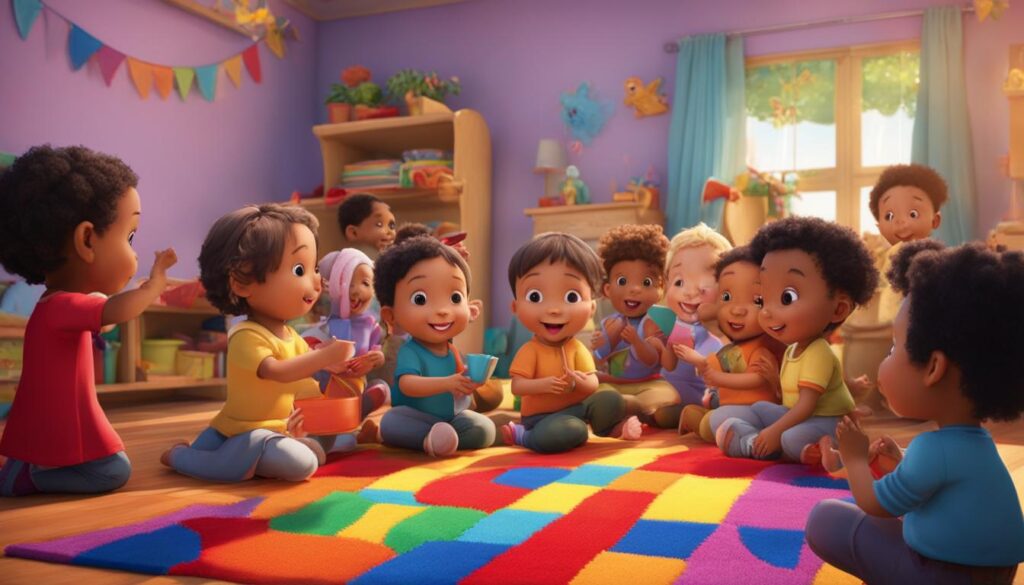We may earn money or products from the companies mentioned in this post.
Are you looking for ways to engage your preschoolers at home? Nursery rhymes are a great way to combine education and entertainment. These classic poems have been passed down through generations and are a cornerstone of early childhood development.
Incorporating nursery rhyme activities in your daily routine can be a fun-filled way to bond with your little ones while also helping them learn and grow. Let’s explore some exciting preschool nursery rhymes and educational nursery rhyme activities that you can enjoy with your kids at home.
Key Takeaways:
- Nursery rhymes are a cornerstone of early childhood development.
- Incorporating nursery rhyme activities into your daily routine can be a fun way to bond with your children.
- Nursery rhyme activities provide an entertaining and educational experience for children.
- By engaging in interactive nursery rhymes, completing worksheets, playing games, and embracing the joy of songs and dances, kids can enhance their language skills and stimulate creativity.
- Get ready to sing and dance along with your little ones!
Interactive Nursery Rhymes for Hands-On Learning
Interactive nursery rhymes are an excellent tool for promoting hands-on learning in children. By involving them in creative activities, kids can learn through play, making the learning process more enjoyable and memorable.
Nursery Rhyme Crafts
Nursery rhyme crafts are a fantastic way to engage kids in hands-on activities while singing along to their favorite rhymes. Crafts like making a sheep mask for “Mary Had a Little Lamb” or creating a spider on a pipe cleaner for “Incy Wincy Spider” allow children to explore different concepts and develop their fine motor skills.
| Activity | Nursery Rhyme |
|---|---|
| Make a paper plate spider | Incy Wincy Spider |
| Create a sheep mask | Mary Had a Little Lamb |
| Decorate a crown | Twinkle, Twinkle, Little Star |
Learning Through Nursery Rhymes
Interactive nursery rhymes provide a fun opportunity for children to explore different concepts and learn new things. By engaging in activities like matching colors to “Rain, Rain, Go Away” or counting sheep for “Baa, Baa, Black Sheep,” kids can develop their cognitive abilities and expand their knowledge without even realizing they are learning.
- Matching colors to “Rain, Rain, Go Away”
- Counting sheep for “Baa, Baa, Black Sheep”
- Learning body parts for “Head, Shoulders, Knees and Toes”
Interactive nursery rhymes provide an enriching learning experience for children. By incorporating nursery rhyme crafts and activities into your child’s routine, you can foster their creativity and imagination while promoting a love for learning that will last a lifetime.
Enhancing Language Skills with Nursery Rhyme Worksheets
Nursery rhymes are not just about fun and games but also play a vital role in enhancing language skills. In this section, we’ll explore various nursery rhyme worksheets and activities for kids that focus on rhyming words.
Through these enjoyable exercises, children can expand their vocabulary and develop their phonological awareness while singing along to their favorite nursery rhymes.
1. Rhyming Words Worksheets
| Worksheet Name | Description |
|---|---|
| Rhyming Word Match | Match the pictures with the words that rhyme. |
| Rhyming Word Maze | Find the path through the maze by following the rhyming words. |
| Rhyming Word Puzzle | Complete the puzzle by matching the rhyming words. |
Using these worksheets, kids can practice identifying and categorizing rhyming words, which helps them with their reading and writing skills in the long run.
2. Fill in the Blank
This activity involves filling in the blank with the correct word that rhymes with the given word. This exercise is a fun way to encourage kids to brainstorm and come up with words that rhyme.
For example:
“Mary had a little ________.”
This activity is not only educational but also promotes creativity and imagination, making it a win-win for parents and children alike.
3. Rhyming Word Bingo
This game is a fun take on the classic bingo game, but instead of numbers, players have to match the rhyming words on their bingo cards. This game is perfect for group activities and promotes social interaction, making it a great choice for playdates or homeschooling.
In conclusion, nursery rhyme worksheets and activities that focus on rhyming words provide an enjoyable way for kids to enhance their language skills. By incorporating these activities into your child’s daily routine, you can make learning a fun and rewarding experience.
Nursery Rhyme Games for Playful Learning
Playing games based on popular nursery rhymes is an excellent way to enhance your child’s cognitive development while having fun. Not only do these games promote social interaction, but they also encourage the use of critical thinking skills. Here are some of the best nursery rhyme games you can play with your little ones:
| Game | Description |
|---|---|
| The Itsy Bitsy Spider | Have your child act out the movements of the spider climbing up the waterspout while you recite the rhyme. Encourage them to try and climb higher and faster with each repetition. |
| Jack and Jill Memory Game | Create a memory game with pictures related to the Jack and Jill nursery rhyme. Place the pictures face down on a table and ask your child to try and match the pairs. You can also add a competitive element by timing how long it takes them to complete the game. |
| Humpty Dumpty Egg Drop | Using raw eggs, challenge your child to build a structure using household items that will prevent the egg from breaking when dropped from a height, just like Humpty Dumpty. This game encourages creativity, experimentation, and problem-solving skills. |
These nursery rhyme games are just the tip of the iceberg. You can use your creativity to come up with your own games inspired by your child’s favorite rhymes. Make sure to adjust the difficulty level according to your child’s age and skill level, and don’t forget to have fun!
Stimulating Creativity with Nursery Rhyme Song and Dance
One of the most enjoyable aspects of nursery rhymes is the catchy tunes and rhythmic patterns that accompany them. Children love to sing and dance along, which makes it a perfect opportunity to stimulate their creativity and imagination. Here are some fun-filled nursery rhyme song and dance ideas for your kids to enjoy:
1. “Head, Shoulders, Knees, and Toes”
This classic children’s song is perfect for promoting physical activity and coordination. Have your child stand up and follow the song’s instructions by touching their head, shoulders, knees, and toes. You can switch up the tempo to make it more challenging or incorporate different body parts to keep it fresh.
2. “Itsy Bitsy Spider”
This beloved rhyme is ideal for developing fine motor skills and hand-eye coordination. Encourage your child to mimic the spider’s movements with their hands and fingers as they climb up the spout, washout, and dry out.
3. “Five Little Ducks”
| Verse | Lyrics |
|---|---|
| 1 | “Five little ducks went out one day, over the hill and far away.” |
| 2 | “Mother duck said, ‘Quack, quack, quack, quack,’ but only four little ducks came back.” |
| 3 | “Four little ducks went out one day, over the hill and far away.” |
| 4 | “Mother duck said, ‘Quack, quack, quack, quack,’ but only three little ducks came back.” |
| 5 | “Three little ducks went out one day, over the hill and far away.” |
“Five Little Ducks” is a delightful nursery rhyme that tells the story of a mother duck and her ducklings. It’s perfect for encouraging counting skills and memory recall. Sit down with your child and sing along, using your fingers to represent each duckling.
4. “The Wheels on the Bus”
This classic nursery rhyme is a favorite among children of all ages. It’s perfect for promoting imagination and creativity, as it encourages children to think about all the different things that might happen on a bus ride. Have your child act out the lyrics by pretending to steer the wheel or honk the horn.
- 5. “Old MacDonald Had a Farm”
“Old MacDonald” is a classic nursery rhyme that introduces children to different animals and the sounds they make. It’s perfect for expanding their vocabulary and promoting creativity. Encourage your child to mimic the animal sounds as they sing along, or even act out the actions of each animal.
Remember, the key to stimulating creativity with nursery rhyme song and dance is to have fun and encourage your child’s imagination. Sing and dance along with your little ones, and watch as their love for music and movement grows.
Conclusion
There you have it! A range of fun and engaging nursery rhyme activities that can be enjoyed by kids and parents alike. These activities not only provide entertainment, but also offer an excellent opportunity for learning. When engaging in interactive nursery rhymes and crafts, completing dexterous worksheets, playing games, and singing and dancing, children can enhance their language skills, stimulate creativity, and develop cognitive abilities such as memory, socialization, and problem-solving.
By incorporating these activities into your daily routine, you can ignite your child’s passion for learning in a fun and memorable way. Who knows, you might even end up learning something new too!
FAQ
What are nursery rhyme activities?
Nursery rhyme activities refer to various fun and engaging games, crafts, worksheets, songs, and dances inspired by popular nursery rhymes. These activities provide an entertaining and educational experience for children at home.
How do interactive nursery rhymes promote hands-on learning?
Interactive nursery rhymes encourage active participation from children. Through nursery rhyme crafts and other hands-on activities, kids can explore different concepts while singing along to their favorite rhymes, making learning a dynamic and enjoyable experience.
What are nursery rhyme worksheets and how do they enhance language skills?
Nursery rhyme worksheets are exercises that focus on rhyming words. By completing these worksheets and engaging in related activities, children develop their phonological awareness and expand their vocabulary, improving their language skills in a fun and effective way.
How can nursery rhyme games benefit children’s learning?
Nursery rhyme games add a playful element to learning. Inspired by popular nursery rhymes, these games encourage social interaction and cognitive development in children, making learning enjoyable and engaging.
How do nursery rhyme songs and dances stimulate creativity?
Nursery rhyme songs and dances are known for their catchy tunes and rhythmic patterns. By singing and dancing along with these rhymes, children can explore their creativity and imagination, fostering a love for music and movement.
Why should I incorporate nursery rhyme activities into my daily routine?
Nursery rhyme activities provide an entertaining and educational experience for children. By engaging in interactive nursery rhymes, completing worksheets, playing games, and embracing the joy of songs and dances, kids can enhance their language skills, stimulate creativity, and have a fun-filled learning journey.
Affiliate Disclosure: This post may contain affiliate links. If you purchase through our link, we may receive a small commission, but at no additional cost to you. For more information, please see our Disclosure statement.



